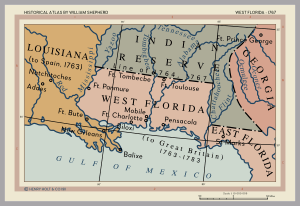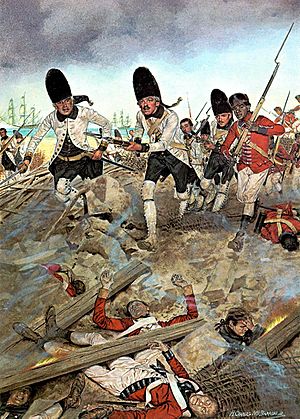British West Florida facts for kids
Quick facts for kids Colony of West Florida |
|||||||||||
|---|---|---|---|---|---|---|---|---|---|---|---|
| Colony of Great Britain | |||||||||||
| 1763–1783 | |||||||||||
 British West Florida in 1767 |
|||||||||||
| Capital | Pensacola | ||||||||||
| Government | |||||||||||
| Governor | |||||||||||
|
• 1763
|
Augustine Prévost | ||||||||||
|
• 1770–1783
|
Peter Chester | ||||||||||
| History | |||||||||||
| 10 February 1763 | |||||||||||
| 1783 | |||||||||||
|
|||||||||||
British West Florida was a special area in North America. It was a colony controlled by Great Britain from 1763 to 1783. After a war, it was given to Spain. Today, parts of this old colony are in the U.S. states of Louisiana, Mississippi, Alabama, and Florida. Great Britain lost control in 1781 when Spain took over Pensacola. Later, parts of this land became part of the United States.
Contents
How British West Florida Was Created
In 1762, during the Seven Years' War, British forces attacked Havana, the capital of Cuba. To get Havana back, Spain agreed to give its land called La Florida to Great Britain. This happened as part of the 1763 Treaty of Paris.
France also gave a large part of its land, New France, to Great Britain. This land was east of the Mississippi River. The British then split this southern area into two new colonies. These were East Florida, with its capital in St. Augustine, and West Florida. The capital of West Florida was Pensacola.
Many Spanish people living in Florida moved to Cuba. New British settlers arrived, including some from the Thirteen Colonies. By a separate agreement, France gave its lands west of the Mississippi River to Spain. This land became Spanish Louisiana, with New Orleans as its capital.
Life in British West Florida
In 1763, British soldiers arrived and took control of Pensacola. George Johnstone became the first British Governor. In 1764, a local government, called a colonial assembly, was set up. This colony was designed like other British colonies in America.
Unlike East Florida, West Florida grew quickly. Thousands of new people moved there. They came to take advantage of the good conditions. People asked the government in London to build churches and provide books. They also asked for help with travel costs to the colonies.
West Florida was asked to send people to the First Continental Congress. This meeting was to complain to King George III about British rules. However, West Florida, along with East Florida, said no. When the American War of Independence started, most colonists in West Florida stayed loyal to the British King.
Who Lived There?
After the Royal Proclamation of 1763, the British hoped new colonies like Florida would help manage settlement. When the Spanish left Florida, most moved from Pensacola. But most French people near Mobile chose to stay.
The British government tried to get non-British people to live in West Florida. For example, a town called Campbelltown was started by Huguenots, who were French Protestants. They were brought to the colony by Lieutenant Governor Montfort Browne. Other groups, like Acadians and Germans, were also encouraged to settle there.
Governor George Johnstone estimated that about 1,800 to 2,000 white people lived in British West Florida. Most lived in Pensacola and Mobile. Others settled along the coast and near Natchez. Many of these settlers were from England, Scotland, or Ireland. There were also French, German, and a few Jewish settlers.
Money and Trade
Slavery existed in British West Florida, but it was not as widespread as in some other colonies. The government wanted to create a society of small farmers and skilled workers. They did not want a colony based on large plantations.
Most people in Florida made a living from farming. They tried to grow crops that could be sold for money, but this was not always easy. However, indigo production grew a lot. By 1772, about 15,000 pounds (6,800 kg) of indigo were shipped from Mobile and Pensacola. This made indigo one of the most successful crops.
Pensacola had much more international trade than Mobile. A lot of West Florida's trade was illegal. It happened between West Florida and Spanish Louisiana. Both British and Spanish leaders knew about this trade. But they could not stop it easily. Because of this trade, Spanish silver coins became the main money used in Florida.
Spain Takes Over
Spain joined the American Revolutionary War in 1779. They fought alongside France, but not with the Thirteen Colonies. Spanish troops, led by Bernardo de Gálvez, moved in and took over Baton Rouge and Mobile. In 1781, Spain captured Pensacola and its British soldiers.
As part of the 1783 Peace of Paris, Great Britain gave West Florida and East Florida back to Spain. When Spain got West Florida in 1783, its eastern border was the Apalachicola River. But in 1785, Spain moved the border eastward to the Suwannee River. This change moved the area of San Marcos and Apalachee from East Florida to West Florida.
See also
 In Spanish: Florida Occidental británica para niños
In Spanish: Florida Occidental británica para niños




